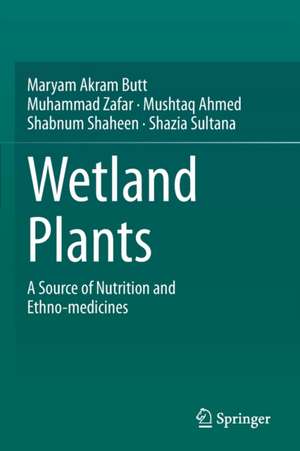Wetland Plants: A Source of Nutrition and Ethno-medicines
Autor Maryam Akram Butt, Muhammad Zafar, Mushtaq Ahmed, Shabnum Shaheen, Shazia Sultanaen Limba Engleză Paperback – 17 mar 2022
Wetland Plants: A Source of Nutrition and Ethnomedicine aims to promote public understanding of this remarkable resource, exploring not only their role in the ecosystem but also their nutritional and medicinal purposes. Based on original research, the text focuses on species identification (with original pictures of wetland plants including morphological features), nutritive value and ethno-medicinal uses. This book serves as an important and basic reference material for further research into the basic biological as well as the applied medicinal aspects of traditional medicinal wetland plants.
| Toate formatele și edițiile | Preț | Express |
|---|---|---|
| Paperback (1) | 1106.12 lei 6-8 săpt. | |
| Springer International Publishing – 17 mar 2022 | 1106.12 lei 6-8 săpt. | |
| Hardback (1) | 1112.15 lei 6-8 săpt. | |
| Springer International Publishing – 16 mar 2021 | 1112.15 lei 6-8 săpt. |
Preț: 1106.12 lei
Preț vechi: 1348.94 lei
-18% Nou
Puncte Express: 1659
Preț estimativ în valută:
211.66€ • 218.36$ • 176.63£
211.66€ • 218.36$ • 176.63£
Carte tipărită la comandă
Livrare economică 27 martie-10 aprilie
Preluare comenzi: 021 569.72.76
Specificații
ISBN-13: 9783030692605
ISBN-10: 3030692604
Pagini: 228
Ilustrații: XXIX, 228 p. 149 illus., 148 illus. in color.
Dimensiuni: 155 x 235 mm
Greutate: 0.37 kg
Ediția:1st ed. 2021
Editura: Springer International Publishing
Colecția Springer
Locul publicării:Cham, Switzerland
ISBN-10: 3030692604
Pagini: 228
Ilustrații: XXIX, 228 p. 149 illus., 148 illus. in color.
Dimensiuni: 155 x 235 mm
Greutate: 0.37 kg
Ediția:1st ed. 2021
Editura: Springer International Publishing
Colecția Springer
Locul publicării:Cham, Switzerland
Cuprins
Foreword.- Preface.- Wetlands and Wetland Plants.- Climate of Wetlands.- Types of Wetlands and Wetland Plants.- Importance of Biodiversity in Wetlands.- Nutritive Value of Wetland Flora.- Medicinally Important Wetland Flora.- Threats to Biodiversity of Wetlands.- Conservation Strategies of Wetland Flora.- Wetland Plants of Himalayas: A case study.- A Pictorial Guide to Wetland plants of Himalayas.- Bibliography.
Notă biografică
Maryam Akram Butt is a Ph.D. scholar in the Plant Sciences Department at Quaid-I-Azam University in Islamabad, Pakistan.
Muhammad Zafar is an Assistant Professor of Plant Sciences at Quaid-I-Azam University in Islamabad, Pakistan.
Mushtaq Amhed is a Professor of Plant Sciences at Quaid-I-Azam University in Islamabad, Pakistan.
Shabnum Shaheen is an Assistant Professor at Lehore College for Women University in Lahore, Pakistan.
Shazia Sultana is a Ph.D. Scholar in the Plant Sciences Department at Quaid-I-Azam University in Islamabad, Pakistan.
Textul de pe ultima copertă
Due to their high nutritive value and the presence of secondary metabolites, wetland plants can be consumed by humans as food and utilized as medicinal drugs. Significant numbers of ethno-botanic resources have been reported to extract useful compounds, which can be used as pharmaceuticals. Wetland plants are also very valuable as an energy source, as fuel for fish smoking and for domestic energy. These plants can be harvested as wild stock, or cultivated in flooded paddies for aquaculture, food and for livestock fodder. All parts of plants can be utilized for foodstuff, compost, mulch, medicine, and for construction.
Wetland Plants: A Source of Nutrition and Ethnomedicine aims to promote public understanding of this remarkable resource, exploring not only their role in the ecosystem but also their nutritional and medicinal purposes. Based on original research, the text focuses on species identification (with original pictures of wetland plants including morphological features), nutritive value and ethno-medicinal uses. This book serves as an important and basic reference material for further research into the basic biological as well as the applied medicinal aspects of traditional medicinal wetland plants.
Wetland Plants: A Source of Nutrition and Ethnomedicine aims to promote public understanding of this remarkable resource, exploring not only their role in the ecosystem but also their nutritional and medicinal purposes. Based on original research, the text focuses on species identification (with original pictures of wetland plants including morphological features), nutritive value and ethno-medicinal uses. This book serves as an important and basic reference material for further research into the basic biological as well as the applied medicinal aspects of traditional medicinal wetland plants.
Caracteristici
Aims to promote understanding of wetland plants, exploring not only their role in the ecosystem but also their nutritional and medicinal purposes Provides original pictures of wetland plants including morphological features Serves as basic reference material for further research into the basic biological as well as the applied medicinal aspects of traditional medicinal wetland plants
